No.1 Exhibition Hall situates on the first floor of the Shaanxi History Museum. It shows the history of
Prehistoric Times (1,150,000 years ago - 21st Century BC), Western Zhou(1046 - 771 BC) to
Qin Dynasty (221 - 206 BC) in the time line of the development of history of Shaanxi. It is not only the history of Shaanxi but also the history of Chinese people.
Relics of Prehistoric Times
(1,150,000 years ago - 21st Century BC)
The entrance is on the left. The first unit, divided into two parts, shows relics from prehistoric times. The first part describes the Paleolithic period. By using reproductions of skulls of Lantian and Dali people, the beginning of the Shaanxi people is shown. The tableau of the Lantian people’s life and a variety of ground stone tools vividly show life scenes of the time.
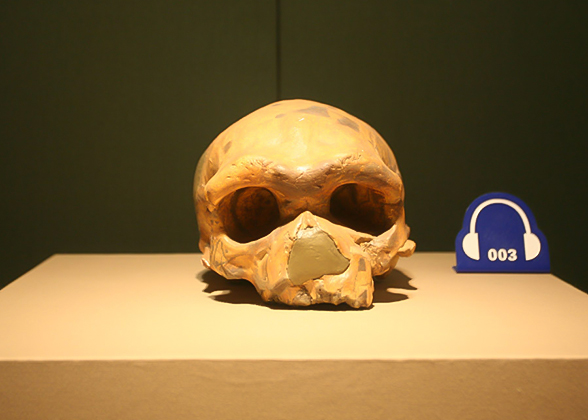 | | Skull of People in Prehistoric Times | | 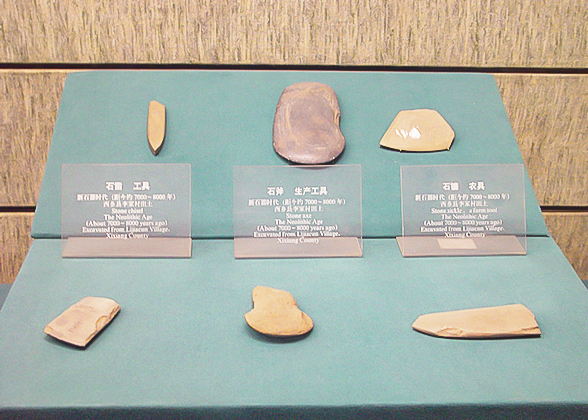 | | Stone Tools from Prehistoric Times | |
The second part includes three early cultures of the Neolithic Period: the Lao Guantai Culture, the
Yangshao Culture and the
Longshan Culture. Among them the
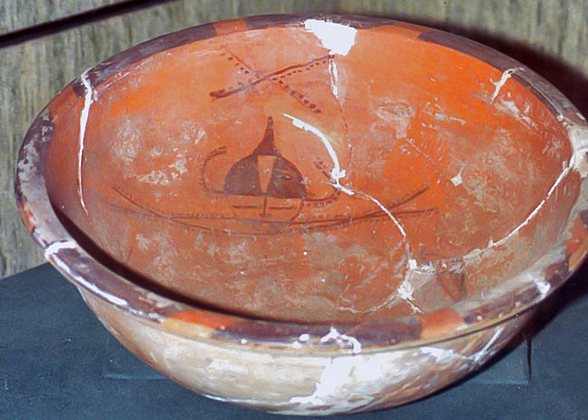 |
| Basin with Fish and Face Patterns |
Yangshao Culture is the most famous. One of the most representative ruins of the Yangshao Culture is in
Banpo Village of Xi'an, Shaanxi Province. The Yangshao culture was a matriarchal society and the Longshan Culture was a patriarchy. Because the Yangshao Culture is also called the “Painted Pottery Culture”, the must-see relics are a V-bottom bottle of red pottery and a pottery basin with patterns of fish and faces. The V-bottom, a typical utensil using for drawing water, is the first exhibit of Yangshao Culture in the museum. Its sharp bottom uses the principles of “center of gravity” and “metacentre”. When the bottle touches water, it will naturally sink to draw water, and it will stand straight when it is full. The basin, displayed in an independent window in the corridor, is a master work of ancient painted pottery. On this basin, the combination of a face with a fish provides much room for guesses by archaeologists, and will surely leave you with a deep impression. It shows the close relationship between fish and people in daily life at that time. In Longshan culture, jade came to people’s life gradually.
Apart from these tools and pottery articles; there are some exquisite ornaments on display such as necklaces made from animal’s bones and hair clasps made of pottery or bone.
 Relics of Prehistoric Times
Relics of Prehistoric Times Relics of Western Zhou Dynasty
(1046 - 771 BC)
After appreciating the wisdom of the people in prehistoric times, you enter a new unit called Western Zhou Dynasty. This unit is generally divided into three parts: the origins of the Zhou people, the foundation of Western Zhou and their culture and economy.
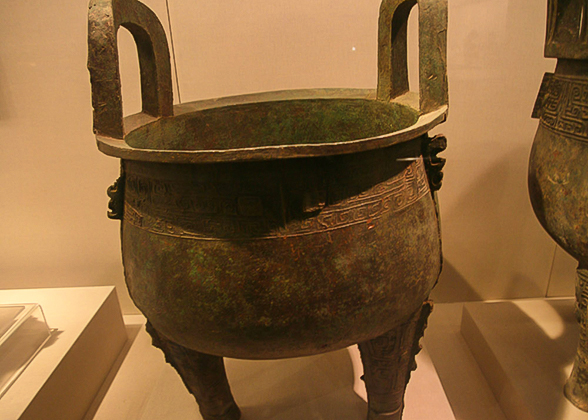 |
| Bronze Cooking Vessel "Tao Tie" |
In the first part, you can see many constructional elements and bronze relics. Among them, two bronze articles draw people’s attention. One is a cooking vessel with “tao tie” (a Chinese special animal) patterns on its body. The other is a spoon with a bronze sheep’s head at the end of the handle. The spoon is used to scoop up wine. Its attractive design also has a tiger and goat on the handle. The tiger is in the process of attacking and the little sheep, with its ears straight up, is struggling to escape. It shows the law of the jungle vividly on a spoon.
With the founding of Western Zhou, the
Zhou Dynasty stepped into a new era. The Western Zhou Dynasty is also called the “Bronze Age”, because various bronze relics have been unearthed. Many relics related to food like “ding” (vessels used to cooking or sacrificing), “li” (drinking vessels), wine bottles, and plates for holding water are on display. Apart from these relics, there are also musical instruments like chimes, which have already three octaves. The various and delicate vessels show not only the advanced techniques of the Western Zhou Dynasty, but also the civilization of Western Zhou. A vessel called “wu si wei ding”, inscribed with the detailed story of a land trade, was used for sacrifice. It reflects that civilization had development to a high level in the Western Zhou Dynasty.
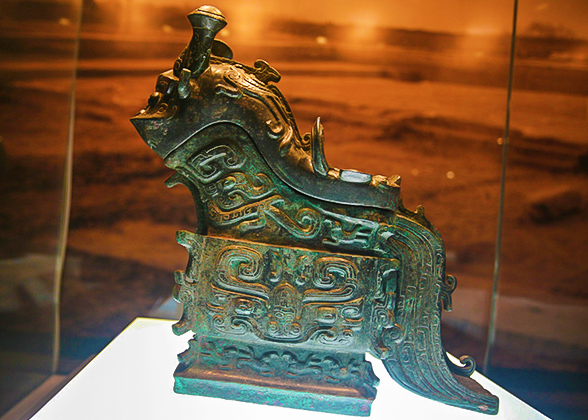 | | Bronze Drinking Vessel Called "Li" | | 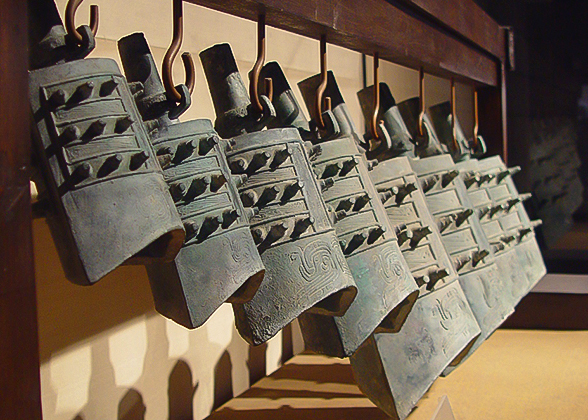 | | Bronze Chime Bells | |
The last section shows relics relating to handicrafts, transportation, shells used as coins and plenty of bronze articles. Among them, a vessel used to hold wine in sacrifice is a Chinese national treasure. It is called “niu zun” in Chinese, and is in the shape of an ox. On the back of this ox there is a tiger standing (on the lid). The tail, body and mouth of the ox are respectively used as a handle, a container for wine and the spout. It is a practical and beautiful vessel. The museum has collected about 2,000 bronze vessels from the Western Zhou Dynasty, and you can enjoy their stunning techniques in the museum.
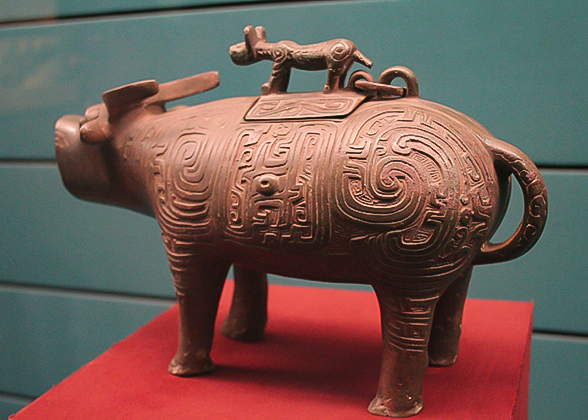 | | Drinking Vessel called "Niu Zun" | | 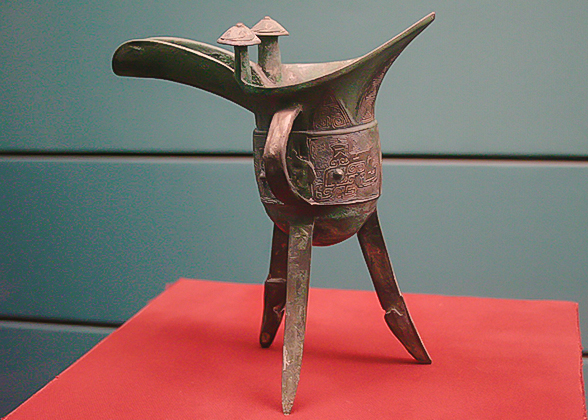 | | Wine Vessel "Jue" | |
 Relics of Shang & Western Zhou Dynasties
Relics of Shang & Western Zhou Dynasties(221 - 206 BC)
The last unit deals with the history of the Qin Dynasty, which has two parts: the rising of Qin and the foundation of Qin. The first part mainly focuses on the construction
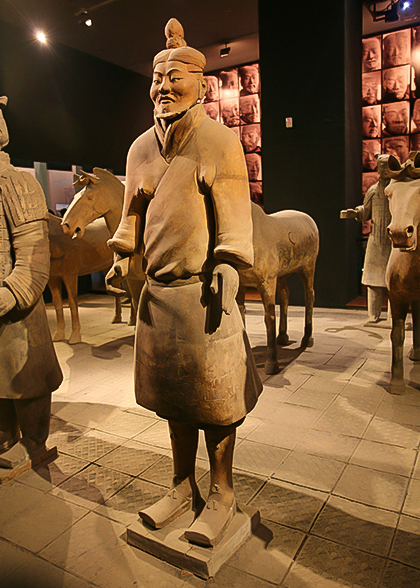 |
| A Terra Cotta Warrior |
and development of the Qin Dynasty, so many construction materials and farming tools are shown here. A stone drum, considered “China’s first antique” is worth seeing. Chinese characters on the drum are the earliest known characters carved on stone in Chinese history. A wine pot has a big belly and a bird-like lid. The wine pot, found at a Waste Recycling Station, was in separate sections. Later, it was identified as a relic of the Warring States Period, so it escaped being melted down. In this unit, you can also see many articles related to tombs in the Qin Dynasty. It represents the culture of that time, which was influenced by the central authority and people’s concept of death.
After the foundation, Emperor Qin Shihuang paid more attention to the military, which you can feel from the variety of weapons shown in the museum. Various single pottery figurines such as a kneeling warrior, selected from the
Terra Cotta Warriors Museum can be seen in this section, which is used to illustrate Qin’s powerful military. You can also see a copper carriage with four horses drawing it. All these tombs reflect attitudes towards death in the Qin Dynasty. Because the Emperor united the Chinese characters, currency and the system of weights and measures, this section displays all kinds of money, characters and measuring implements from before and after the Qin Dynasty’s founding.
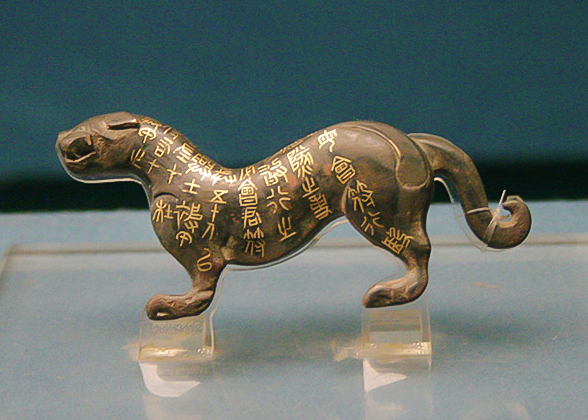 | | Tiger-Shaped Tally for Generals | | 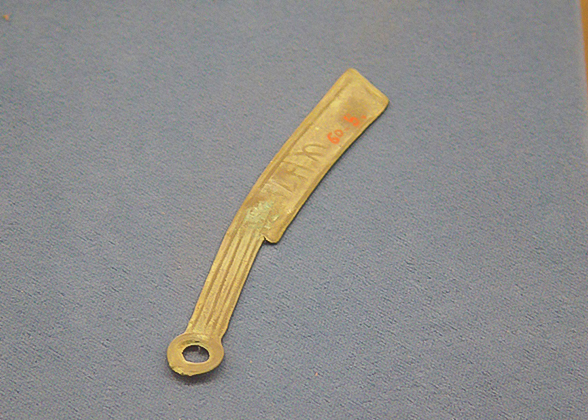 | | Knife-Shaped Currency in Qin Dynasty | |
 Relics of Eastern Zhou and Qin Dynasties
Relics of Eastern Zhou and Qin DynastiesGo to the No. 2 Exhibition Hall
- Last updated on Jun. 07, 2024 by Gabby Li -
 Relics of Prehistoric Times
Relics of Prehistoric Times Relics of Shang & Western Zhou Dynasties
Relics of Shang & Western Zhou Dynasties Relics of Eastern Zhou and Qin Dynasties
Relics of Eastern Zhou and Qin Dynasties










